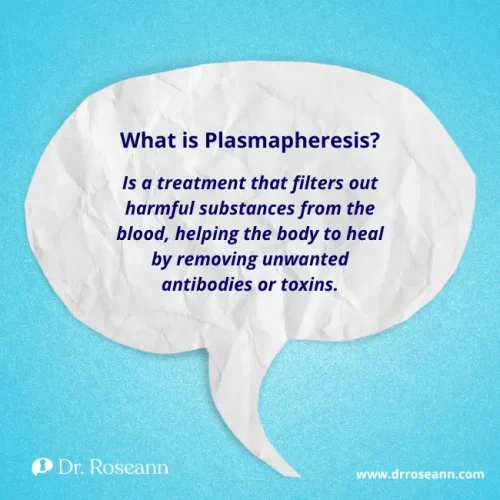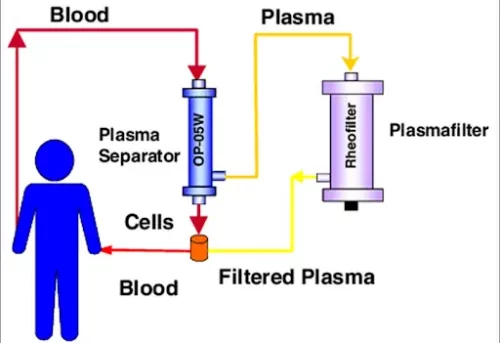Estimated reading time: 5 minutes
If your child’s personality flipped overnight — you’re seeing tics, obsessive thoughts, and out-of-nowhere meltdowns — you’re not imagining it. That might be PANDAS, where the immune system goes after the brain instead of an infection like strep.
When things feel intense and nothing seems to help, some parents turn to a treatment called plasmapheresis. It works by clearing out the antibodies that may be attacking the brain after something like strep.
What Is Plasmapheresis for PANDAS?
Plasmapheresis for PANDAS (also called plasma exchange) is like giving your child's immune system a reset. It removes the antibodies in the blood that may be attacking your child’s brain and are the reason behind those sudden mood shifts, tics, or behaviors.
In kids with PANDAS, the immune system can get “stuck” in attack mode. This treatment helps clear out some of that confusion. It’s not usually the first option doctors try — but for some kids, it can be a powerful way to calm the chaos and help the brain feel safe again.

How Does Plasmapheresis Work?
The Plasmapheresis procedure involves the following steps:
- Blood Withdrawal: Blood is withdrawn from the patient with PANDAS.
- Separation: The plasma (the liquid part of the blood), which contains the harmful antibodies, is separated from the blood cells.
- Replacement: The removed plasma is now replaced with a substitute, such as a protein solution albumin or donor plasma.
- Return: The cleaned blood cells, along with the replacement plasma, are then returned to the patient's body.
This gentle process helps lower the number of harmful antibodies that may be causing those sudden changes in mood, behavior, or tics. It’s one of the ways we can help calm an overwhelmed immune system. These improvements often include enhanced behavior and emotional regulation, which are observed shortly after undergoing the procedure.

Plasmapheresis vs. IVIG: A Side-by-Side Comparison
Both plasmapheresis and Intravenous Immunoglobulin (IVIG) are treatments aimed at modulating the immune system, but they work differently and have distinct considerations.
| Aspect | Plasmapheresis | IVIG |
|---|---|---|
| Mechanism | Removes harmful antibodies from the bloodstream | Introduces healthy antibodies to modulate immune response |
| Procedure | Invasive; requires vascular access | Less invasive; administered via infusion |
| Duration | Multiple sessions over several days | Typically one or two sessions |
| Side Effects | Risk of infection, bleeding, low blood pressure | Headache, fever, nausea |
| Effectiveness | Rapid symptom improvement in some cases | Gradual improvement over weeks |
| Cost | Generally higher due to complexity | Variable; often covered by insurance |
Note: The choice between plasmapheresis and IVIG should be made in consultation with a healthcare provider, considering the patient's specific condition and response to previous treatments.
What Are the Risks and Side Effects of Plasmapheresis?
While plasmapheresis can be effective, it carries potential risks:
- Infection: Due to the invasive nature of the procedure.
- Bleeding: From catheter insertion sites.
- Low Blood Pressure: During or after the procedure.
- Electrolyte Imbalances: Such as low calcium levels.
- Allergic Reactions: To replacement fluids that are used in the procedure.
Note: Make sure to have the procedure performed in a specialized medical center equipped to manage these risks.
Expert Insights on Plasmapheresis for PANDAS
- Dr. Daniel Kinderlehrer, a prominent integrative medicine physician, has shared a hopeful case study of a teenager whose psychiatric symptoms—including depression, anxiety, and behavioral changes—were misdiagnosed as mental illness. When they diagnosed his situation further, Lyme disease was identified as the underlying cause. This case tells us the importance of considering tick-borne illnesses in patients presenting with psychiatric symptoms. For a detailed account, read the full story here: Dr. Kinderlehrer's Case Study on Lyme Disease and Psychiatric Symptoms.
- Dr. Susan Swedo is the one who first identified PANDAS. She has also spoken about the potential benefits of plasmapheresis, specially for children who haven’t responded to other treatments.
A Holistic Approach to PANS/PANDAS
Managing PANDAS requires more than one treatment—it’s about a holistic approach. Ella, a 9-year-old, went from daily meltdowns to thriving after her family focused on anti-inflammatory foods, consistent sleep routines, and cutting out toxins. With the help of a PANDAS specialist, Ella’s symptoms eased, and her joyful personality returned.
The key is working with a healthcare professional to create a personalized plan. It's not just about managing symptoms, but helping your child reclaim their happiness.
Want to learn more? Check out my Natural PANS/PANDAS Calm Brain Kit for actionable steps.
Parent Action Steps
Navigating PANDAS can be overwhelming, but here are steps to consider:
How the BrainBehavior Reset™ Program Can Help
Dr. Roseann's BrainBehavior Reset™ Program offers a comprehensive approach to treating PANDAS by combining neurofeedback, biofeedback, and other evidence-based therapies. This program aims to regulate the nervous system, reduce inflammation, and improve behavioral outcomes.
It's designed to complement medical treatments like plasmapheresis and provide holistic support for your child's recovery.
Frequently Asked Questions
How quickly can I expect to see improvements after plasmapheresis?
Some patients report improvements within days, while others may take weeks. Individual responses vary.
Is plasmapheresis a cure for PANDAS?
Plasmapheresis can alleviate symptoms but is not considered a cure. Ongoing management may be necessary.
Will insurance cover plasmapheresis?
Coverage varies by provider and policy. It's essential to consult with your insurance company beforehand.
Can my child undergo plasmapheresis more than once?
Yes, but the frequency and number of treatments should be determined by a healthcare provider based on the child's response and overall health.
Citations
Perlmutter, S. J., Leitman, S. F., Garvey, M. A., Hamburger, S., Feldman, E., Leonard, H. L., & Swedo, S. E. (1999). Therapeutic plasma exchange and intravenous immunoglobulin for obsessive-compulsive disorder and tic disorders in childhood. The Lancet, 354(9185), 1153–1158. https://doi.org/10.1016/S0140-6736(99)02174-3
Cunningham, M. W. (2019). Molecular mimicry, autoimmunity, and infection: The cross-reactive antigens of group A streptococci and their sequelae. Microbiology Spectrum, 7(4), 10.1128/microbiolspec.GPP3-0045-2018. https://doi.org/10.1128/microbiolspec.GPP3-0045-2018
Swedo, S. E., Leonard, H. L., Garvey, M., Mittleman, B., Allen, A. J., Perlmutter, S., Lougee, L., Dow, S., Zamkoff, J., & Dubbert, B. K. (1998). Pediatric autoimmune neuropsychiatric disorders associated with streptococcal infections: Clinical description of the first 50 cases. American Journal of Psychiatry, 155(2), 264–271. https://doi.org/10.1176/ajp.155.2.264
Kinderlehrer, D. A. (2020, July 30). Does your child have a mental illness—or a medical disorder? LymeDisease.org. https://www.lymedisease.org/kinderlehrer-crazy-sick/
Dr. Roseann Capanna-Hodge is a licensed mental health expert that is frequently cited in the media:
- The Mac Talks: Fighting the Stigma on Mental Health & Lyme Disease
- Learning to Slay the Beasts Podcast: Treating PANDAS, PANS and Lyme
- Clearly Clinical Podcast: What you need to know about PANS/PANDAS
Always remember… “Calm Brain, Happy Family™”
Disclaimer: This article is not intended to give health advice and it is recommended to consult with a physician before beginning any new wellness regime. *The effectiveness of diagnosis and treatment vary by patient and condition. Dr. Roseann Capanna-Hodge, LLC does not guarantee certain results.
Are you looking for SOLUTIONS for your struggling child or teen?
Dr. Roseann and her team are all about science-backed solutions, so you are in the right place!
Are you looking for solutions for your struggling child? Get a complimentary from Dr. Roseann









